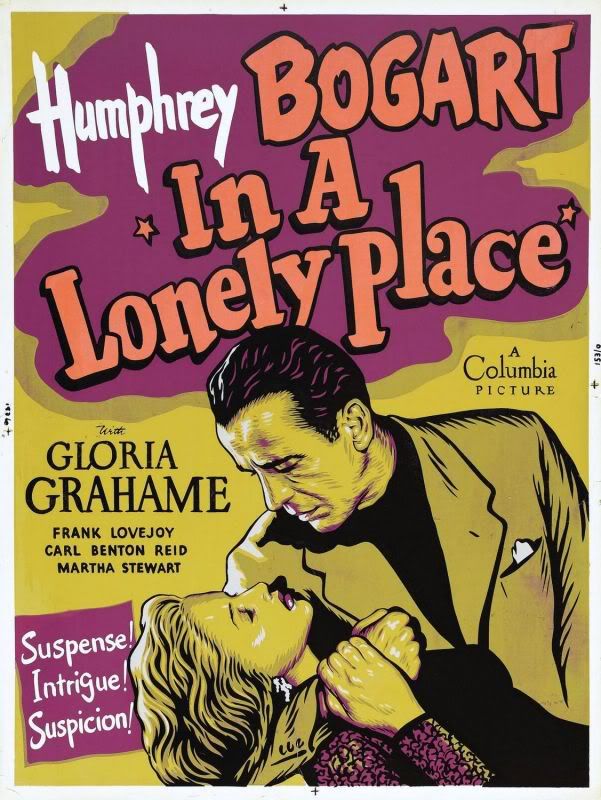The film poster says it all really. Humphrey Bogart holds Gloria Grahame in a passionate clinch, her eyes closed in orgasmic bliss. But take a closer look... is he actually strangling her? And is that a look of menace on his face? Perhaps she is already dead? Maybe this isn't the great romance we originally thought it to be. Maybe it's something a little more destructive.
In a Lonely Place is a film noir-come-melodrama directed by Nicholas Ray. Bogart plays Dixon Steele a cynical and not particularly successful Hollywood screenwriter with major anger management issues. Gloria Grahame plays the equally brilliantly named Laurel Gray, the sultry neighbour of Dix who firstly acts as his alibi for murder and then falls in love with him. The love story is the main thrust of the plot alongside the police investigation into the killing of a coat-check girl who was helping Dix with a script. As the film progresses Laurel's suspicions that he may in fact be the murderer increase. It is her rising panic and paranoia that drive the story along, coupled with Dix's charm and nonchalance as the net seems to be closing in on him.
The plot and themes of the movie stem from the characters and both of the main protagonists are vivid three dimensional personifications with flaws aplenty. The role of Dixon Steele has depth and complexity by the bucket load, and Bogart really sinks his teeth into it. Sardonic yet also threatening he mixes dry witticisms with a bitter rage that is always bubbling near the surface. In the first reel of the film he gets involved in two separate spats, first an angry exchange of words with another driver at a crossing and then in a bar when someone loudmouth slags off an actor friend of his. It soon comes to light that these are just the latest in a long list of altercations. The message is clear - do not mess! Yet he also reveals the lonely and disturbed side of a character low on confidence and lacking in self esteem, the bottom lip chewed to distraction in typical style. It's classic Bogart.
Likewise Gloria Grahame's performance is considered one of her best. Grahame made a career playing vulnerable yet extremely desirable femme fatales and gangster's molls who usually meet a sticky end. She had hot coffee thrown in her face by Lee Marvin in The Big Heat and was throttled to death by Broderick Crawford in Human Desire. Yet that sly Southern drawl, the merest rise of an eyebrow and the exhalation of a plume of cigarette smoke suggests a cunning and devious mind at work, most often driven by sex and desire.
The third corner of the triangle is the director Nicholas Ray. Ray was a bisexual Hollywood maverick and wild man, a hardcore drinker and drug-taker who directed some of the most provocative pictures that came out of the Hollywood studio system in the 1940s and 1950s - They Live by Night, Johnny Guitar and Rebel Without a Cause to name a few. Unsurprisingly, he drove the powers that be to distraction with his antics and increasingly left-field films and was eventually shut out by the Hollywood establishment. In his later years he was celebrated by German director Wim Wenders who cast him in his film The American Friend and co-directed Ray's final film Lightning Over Water.
Gloria Grahame and Ray were in a tempestuous marriage at the time In a Lonely Place was being made. The relationship actually broke up whilst the film was being shot. Such was Ray's macho paranoia, he forced Grahame to sign a humiliating stipulation to her contract on the movie, which gave her little or no say in the development of her role at all, nor was she allowed to vent frustration at her lack of independence. Ray even took to sleeping in a dressing room so that no one could discover the truth that director and leading lady were no longer an item. Legend has it that the couple finally divorced a couple of years later when Ray found Grahame in bed with his thirteen year old son.
It's this sense of marital mistreatment that works it's way into the heart of the movie. It's obvious by the end of the film that the "lonely place" of the title refers to jealousy, insecurity, vitimisation, low self esteem and self-destructive behaviour that ultimately leads to violence, raw emotions that can only be played out by those that have experienced them...
Bogart takes Gloria Grahame for a ride out to the dark side

No comments:
Post a Comment